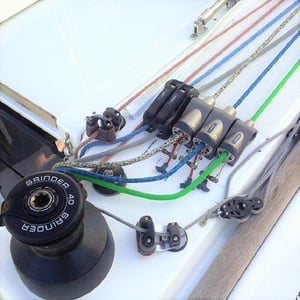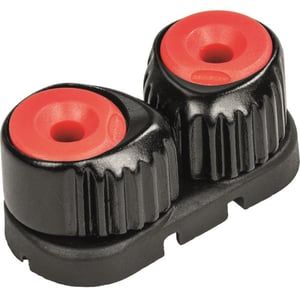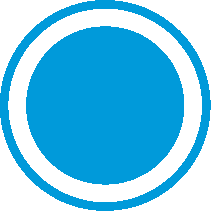.jpg?width=600&name=Belcher%20%26%20Ryan%20-%20%C2%A9%20Victor%20Kovalenko%20(cc%20Facnor).jpg)
Image Credit: Ronstan © Victor Kovalenko
Your sailing system is only as strong as the weakest link. Often overlooked, high performance boat cleats are a crucial part of a larger, functional sailing system.
Composed of two spring-loaded, v-shaped cams with teeth, cam cleats firmly hold lines on dinghies, yachts and small keel boats.
Easy to operate, boat cleats are the optimal choice for securely holding sheets, control lines (such as traveller lines, vangs, dagger boards) and other handheld lines and can accommodate impressive safe working loads up to 450kg (1000lb).
To use a cam cleat, simply pull on the loaded line and the cams will open automatically, allowing the line to slide between them until you release the line, at which point the teeth bite onto the line and hold it securely in place. To release, merely tension the line by hand and pull upward and away from the cam cleat in a singular, fluid motion.
In applications involving constant line adjustment and trimming, boat cleats offer a significant advantage over clutches and jammers, which should be instead considered for longer duration, higher load applications - such as halyards.
 |
 |
| Ronstan Cam Cleat - Alloy C-Cleat |
Sounds good – but what’s available on the market?
Boat cleats are manufactured from three main materials: composite (high tech plastics), aluminium and stainless steel.
Whilst composite cam cleats are a budget-friendly option that provide effective and long-lasting performance, aluminium boat cleats can be stronger, are highly resistible to UV degradation, and can be maintained through replacement of ball bearings and plastic components.
With regards to load, stainless steel boat cleats are the most effective when dealing with high loads and are therefore common onboard larger boats and super yachts (and tend to be the most expensive!).
All cam cleats can be optimised via the addition of various boat cleat accessories. Potential add-ons include:
- Fairlead – Pull and cleat the line at diverse angles (extreme angles possible)
- Wedge – Improve boat cleat alignment by adjusting the angle of the cam cleat (forwards or backwards)
- Eye strap – Keep the appropriate rope close to the boat cleat for fast recleating
- Rope Guide – Redirect a line that is not fairly lead into the centre of the cams
- Curved Surface Adapter – Mount a cam cleat to a curved surface (such as the mast or boom)
- Riser – Raise a boat cleat to increase accessibility
As is the case with all sailing hardware, using a subpar boat cleat can result in decreased performance: lines can slip, sail trim can be imprecise, or you might face difficulty un-cleating. To avoid these situations, it is best to invest in a quality cam cleat.
Harken and Ronstan are both industry leading manufacturers of cam cleats, supplying boat cleats in micro (small), standard (medium) and offshore (large) sizes for a range of rope diameters.
Both manufacturer’s product ranges are lightweight, strong and durable: Harken use three tiers of high-efficiency bearings which ensures a (very) stable but low friction cam, whilst Ronstan’s multi-coil generates near constant torque, securing cleating of even the smallest lines with minimal rope wear.
If you have any questions about cam cleats, please feel free to email us at support@upffront.com, or click the link below to see our full range:




